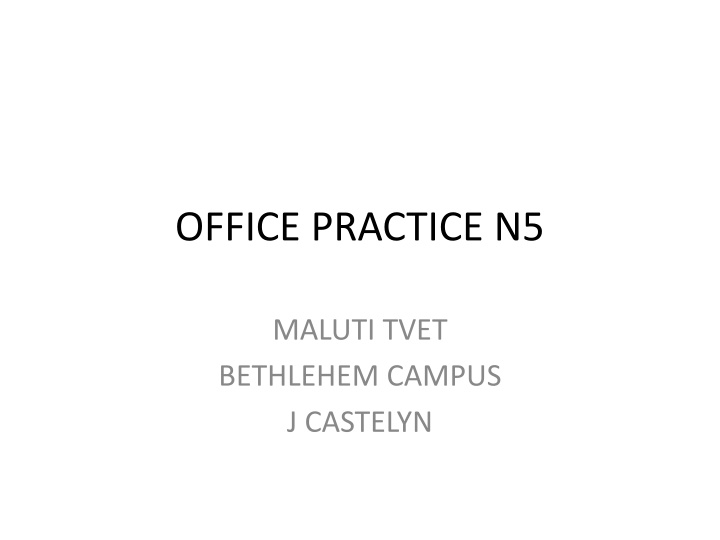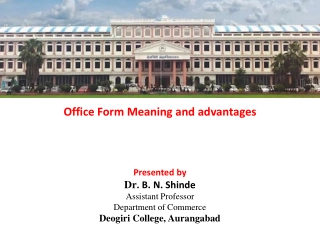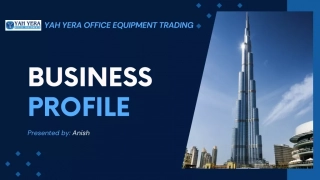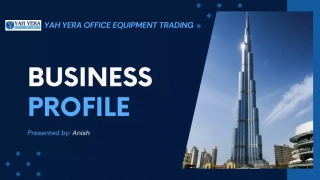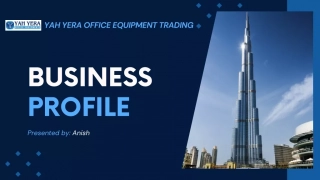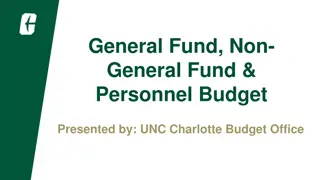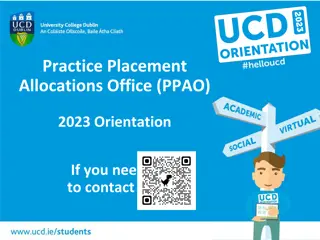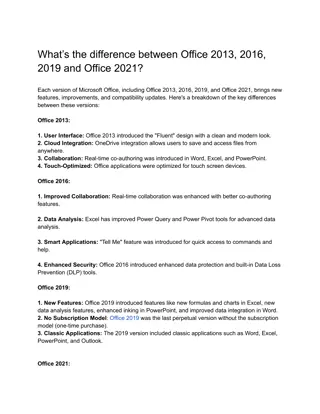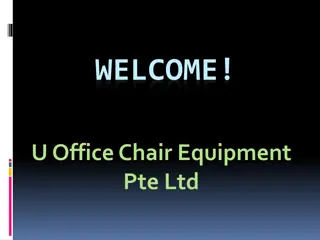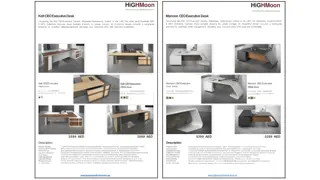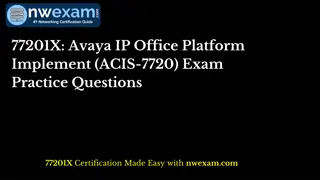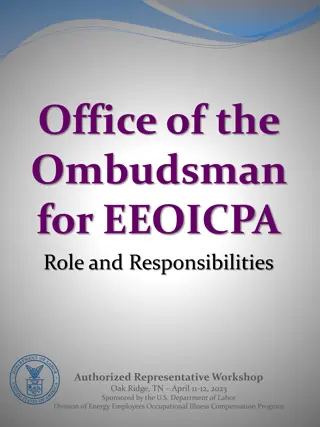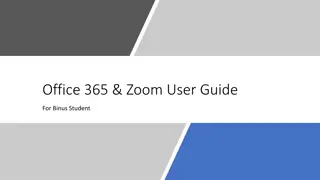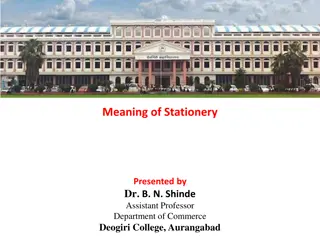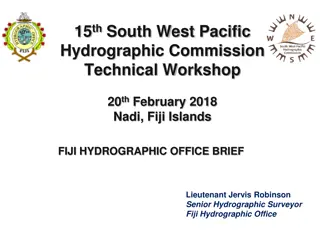OFFICE PRACTICE N5
World of financial services and products, including the role of banks, investment institutions, and insurance companies in providing essential financial assistance and support to individuals and businesses. Learn about the wide range of services offered by banks, such as safekeeping of money, financial assistance, foreign currency transactions, and various financing options like loans, mortgages, and credit cards.
Download Presentation

Please find below an Image/Link to download the presentation.
The content on the website is provided AS IS for your information and personal use only. It may not be sold, licensed, or shared on other websites without obtaining consent from the author.If you encounter any issues during the download, it is possible that the publisher has removed the file from their server.
You are allowed to download the files provided on this website for personal or commercial use, subject to the condition that they are used lawfully. All files are the property of their respective owners.
The content on the website is provided AS IS for your information and personal use only. It may not be sold, licensed, or shared on other websites without obtaining consent from the author.
E N D
Presentation Transcript
OFFICE PRACTICE N5 MALUTI TVET BETHLEHEM CAMPUS J CASTELYN
Topic 7: Auxiliary services Financial services and products
1. FINANCIAL SERVICES: FIVE FINANCIAL SERVICES: 1.1 1.2 1.3 1.4 1.5 BANKS BUILDING SOCIETIES INSURANCE COMPANIES ACCEPTANCE BANKS DISCOUNT HOUSES
1.1 BANKS MERCHANT / COMMERSIAL BANKS/ INSTUTIONS: Offers wide range of financial and related services with a widely distributed network throughout the country. Has a nationwide network of ATMs and internet banking facilities available. Commercial banks fall under the Reserve Bank, while investment and merchant banks remain the most competitive banks in the country. The four biggest banks in the country are ABSA, FNB, Standard Bank, NEDBANK, continue to consolidate their grip on the retail market.
Banks SERVICES OFFERED BY BANKS: Safekeeping of money, other valuables or important documents on behalf of customers Financial assistance on matters such as insurance, investments and taxation from the bank Foreign currencies to business people to pay for imported goods and to travellers and tourists Pay for goods and services bought, either by cheque, debit order or credit transfer Customers can also go through their banks to receive payments for goods and services sold The bank will accept payments from people and businesses that pay money into a specific account held with the bank. Banks enable customers to transfer funds between different accounts at the same bank and to accounts at other banks without withdrawing the money , not to handle cash in the process. Provide finance to customers in the form of loans, mortgage bonds and overdrafts Banks charge interest on money customers borrow. Banks provide ATMs from which cash can be withdrawn by accountholders 24hrs a day, avoiding long queues. Instalment sale financing: items are paid off in instalments over a period of 6 60 months. Financing on lease: ownership of purchased goods never passes to the purchaser not even when fully paid. Mortgage bond financing: loans for purchasing and building homes. Credit cards: used for all purchases where accepted. Travellers cheques: it is accepted anywhere in the world and sold by commercial banks.
Banks: Services offered by banks: Bank guarantees: For property and other transactions, to protect the interests of both the purchaser and seller. Bill discounting: on presentation of the bill of sale the bank pays the amount on the bill to the company. The bank loan is repaid when the company receives the payment for the goods. Bank drafts: for foreign and domestic use when a business wants to buy goods, but the seller does not want to ship the goods before he is certain that he will be paid. Student loans: available to good applicants to continue their studies, permanent residents of South Africa. Letters of credit: Domestic and foreign Foreign exchange, transfers are made in foreign currencies or ZAR by means of SWIFT. Bank reports Wide variety of sundry services like insurance, buying and selling of shares, finalising estates and wills.
Advantages of keeping money in a bank: To keep money safe for people / businesses. Money deposited in the bank earns interest for the account holder. Do not need to count your money regularly. Banks statements shows deposits, withdrawals and balances and sent to you regularly. The account holder may transfer money to another person or business by means of a cheque or electronic funds (EFTs). Reduces the risk of carrying large amount of cash on your person.
1.2. BUILDING SOCIETIES Building Societies no longer exist in South Africa. Most of them are incorporated into one of the four major commercial banks operating in the South African market. Services offered previously are taken over by banks. Offered to public home loans or mortgage bonds. Other institutions also offer home loans like SA Home loans, SA Bond Traders, specialising only in offering home loan at a lower interest rate offered by banks. The National Credit Act (NCA) became effective to protect the consumer against unfair and unlawful credit provision. The NCA prevent reckless credit behaviour by both the credit provider and the consumer. It also educate customers about their rights. It applies to all credit agreements. All credit providers are required by law to comply with the NCA or they will not be allowed to offer credit terms. When applying for a bond you are required by the NCA to complete a form and submit relevant documentation.
1.3 INSURANCE COMPANIES FUNCTION S/SERVICES OF INSURANCE COMPANIES: Carry the risk of death and disability, accident and insurable disasters, fire, theft etc. Provide security to employers against theft, accidents, dishonesty of employees etc. Provide security to the individual that provides for his/her old age and dependants in advance. Channel savings of individuals collectively into productive investments Serve as a source of capital for trade and industry. Fund the government by means of investments in government Bonds. Provide funding to local authorities and public institutions, Invest in the JSE to ensure an affective stock exchange in the country. Invest in property like office buildings and factories. Grant loans to policy holders. Accept policies as security to banks when loans are negotiated. Administer pension- and medical aid funds.
TYPES OF INSURANCE COMPANIES SHORT TERM INSURANCE COMPANIES: Carry the damages or losses of the insured arising from fire, theft, accidents and public accountability. They compensate only for damages actually suffered. E.g. Auto and General Insurance, Mutual and Federal, Santam etc. LONG TERM INSURANCE COMPANIES: Focus on life assurance. Offer various other kinds of assurance policies like funeral insurance, annuity assurance, industrial insurance. Life assurance is taken out as security against death, disability or attainment of a specific age. E.g. Allan Grey Life Limited, Liberty Life Group Limited, Sanlam Life Insurance Limited etc.
1.4. ACCEPTANCE BANKS Employ financial advisors who specialise in specific fields of finances. Play an important role in the South African economy for large companies. Serve mainly the corporative market and thus have only a small number of clients that invest or borrow large sums of money from them. SERVICES OFFERED: Acceptance of bills that can be discounted with the South African Reserve Bank Acceptance of large investments. Advice on investments Purchase or discount of bills of trade relating to moveable goods. Short- and medium term loans. Underwriting of new share issues and bonds.
1.5. DISCOUNT HOUSES Deal mainly with mining houses and banks. Use deposits made by customers and lend these funds to larger companies on a shorter term. FUNCTIONS / SERVICES: Buying and selling of financial assets. Grant short-term loans to financial institutions. Invest surplus funds in liquid assets. Regulate the liquidity in the banking sector with the acceptance of surplus funds from the banks and mining houses.
2. FINANCIAL PRODUCTS 2.1 COMPARING FOUR FINANCIAL PRODUCTS: 2.1.1 CURRENT ACCOUNT 2.1.2 SAVINGS ACCOUNT 2.1.3 FIXED DEPOSITS 2.1.4 INVESTMENTS
COMPARING FOUR FINANCIAL PRODUCTS: 2.1.1 CURRENT ACCOUNT Deposit money in the account and withdraw money with a cheque, debit order or a cash/credit/garage card. Credit balance on the account earns a small interest. High interest is charged when the account is overdrawn. Minimum interest is paid on favourable balance. Acceptable method of payment. A safe place to keep cash and to receive payments. The transfer of funds (debit orders) Its a means to borrow money (overdraft facilities). Bank charges include: credit card levies, cheque book , cash deposits, tax, service, debit order, internet and banking fees. Receive monthly bank statements. May arrange for an overdraft facility when the account is overdrawn. Only commercial banks are allowed to offer current account holders an overdraft facility. 2.1.2 SAVINGS ACCOUNT Effective and flexible way to save money . Easy way to control spending funds. Money can be deposited and withdrawn over the counter. Money can be deposited or withdrawn at an ATM 24 hours a day. Overdraft facilities are not available. Fee charged is lower as for a current account. Interest is earned on the daily balance. Can be used to keep your salary safe. Issued a card with a PIN.
Advantages: Savings account: Easy to open and operate. Funds available 24hrs a day. Funds available throughout SA. Interest is earned at market related rates. No or low bank charges. No maximum limit. Regular statements on which transactions are shown. stop and debit orders. Current account: Private accountholders gets a cheque book and ATM card. Have instant access to funds through a cheque book, debit card, garage card etc. Some banks automatically guarantee cheques to a certain amount. An instrument used to access other financial services. Regular bank statements on which all transactions are shown. Serves as a source document for accounting purposes. Interest is earned on credit balances Funds are immediately available except uncleared cheques deposited into the account. Don t have to carry large amounts of cash. Interest is earned on credit balances. Cheques can be used to pay other people / businesses to whom the account holder owes money.
COMPARING FOUR FINANCIAL PRODUCTS: 2.1.3 Fixed deposits 2.1.4 Investments Can be short-term or medium term The investor can do business with the financial sector of his choice. Different forms of investments are available to individuals, businesses and organisations The choice of investment depends on the amount and period. Choice of sectors to use: banks, insurance companies, acceptance banks, discount houses and JSE. Clients enjoy maximum security in a declining interest rate number. Clients receive regular interest income whilst securing their investment on the amount deposited. Minimum requirements apply in terms of the amount and time of investment when investing money in a fixed deposit at a bank. Anyone who does not need their money immediately can open a fixed deposit. Cannot withdraw money from this account until the end of the investment period.
Advantages: Fixed deposits Deposits enjoy maximum security in a declining interest rate market. Interest rate is fixed for the term of the investment. Fixed deposits can serve as security. Adaptable to client needs. Interest can be paid monthly , quarterly or annually. A certificate with full details is issued. Your investment is secured. You have a choice of 3, 6, 12 18 or 24 months. Investments Short-term: Make most of your money with small risk and not many penalties Can be converted into cash or rolled over into other short-term or long-term investments Long-term: Have the ability to add small amounts of money over a longer period of time. The slow but steady pace allows for much more stability and a much lower risk than short term investments. They are ideal for making your savings or retirement funds grow.
Current account and overdraft facility: PURPOSE/ REASON FOR OPENING Current account: For convenience purpose of the business or personal client. It bears little interest The customer can withdraw or deposit any amount of money , many times, subject to availability of funds. Overdraft facility: Occurs when withdrawals exceeded the available balance. Not sufficient funds in the account of the account holder. Gives the account a negative balance and means the account provider is providing credit. The amount overdrawn must be within the authorised agreement prior with the account provider. Interest is charged at the agreed rate. If the balance exceeds the agreed facility then fees may be charged and a higher interest rate apply.
2.2.1 OPENING A CURRENT / CHEQUE ACCOUNT: Arrange with a bank official and inform him/her about the reason for opening a current account. Have the necessary documents required. Complete the application form by giving your personal details. Supply the bank with at least two specimen signatures of every person that will be authorised to sign cheques. The following documents are important when applying:two specimen signatures, application for a chequebook Complete a deposit slip for the initial deposit and ensure you receive the stamped duplicate.
2.2.2 OVERDRAFT FACILITY: CRITERIA FOR GRANTING: OPENING / APPLICATION Ask the bank for an overdraft. Documents needed: SA ID, proof of residence, and proof of income. The bank do a credit assessment to ensure account holders can afford the overdraft. The limit available is based on an assessment of the account holder s monthly income and expenditure and credit information supplied by the credit bureau. The account holder and family are protected in the event of death or disability by taking out overdraft assurance. The client must apply for an overdraft. The client must have a healthy financial status. The client must provide sufficient security to cover the bank against a loss.
2.3 CHEQUES: DEFINITION: A written instruction from a person with a current bank account to the bank instructing them to pay a certain sum of money to the person/institutions specified on the cheque on demand. OR An unconditional, signed, written instruction to a bank to pay on presentation, the amount of money indicated on the cheque, to said person, his order or to the bearer.
2.3.1 EIGHT TYPES OF CHEQUES: Stale: Bearer: older than 6 months. Not be honoured by banks. payable to the person specified therein or who presents it to the bank for payment. The words or bearer appear on the face of the cheque are NOT cancelled. payable to the person specified therein as the payee or to anyone else to whom it is endorsed (transferred). The word bearer appearing on the face of the cheque is cancelled and when in its place the word or order is written on the face of the cheque. Uncrossed/open: not crossed. Can be withdrawn at the counter and may be a bearer or and order cheque. General crossed: drawing 2 parallel lines on the face of the cheque with or without additional words like &CO or Not Negotiable or A/c. Payee/Account Payee between the parallel lines. Cannot be cashed / exchanged for cash at a bank teller. Can only be paid into and credited to the payee s account. Restrictive/ special crossed: a particular bank s name is written between the two parallel lines on the face of the cheque with the words A/c. Payee only. Anti-dated: have a date earlier than the date on which it is presented. Only valid up to 6 months from the date of the cheque. Post-dated: have a date in the future date. Will not be honoured before the date written on the cheque. Order:
2.3.2 PARTIES INVOLVED WITH A CHEQUE DRAWER: PAYEE: the account holder the person/firm whose name appears after the words Pay/Betaal DRAWEE bank: the bank where the account is held. DOMICILE: the branch of the bank where the account is held.
2.3.3 INFORMATION ON A CHEQUE: Amount / Bedrag: written in words Cheque nr: serial nr of the cheque. Printed in magnetic ink on lower left side of the cheque Sort code: The 6-figure numbers after the serial number, printed in magnetic ink. Account number: the 10 figures after the sort code, printed in magnetic ink. (unique number) Amount in figures: in the block Date: must be dated in the correct format Clearing number: 8-digit nr by which the bank, branch, post area and clearing area is indicated
2.3.5CROSSING A CHEQUE It means that two parallel diagonal lines are drawn across the face of the cheque thereby instructing the bank that the cheque should be paid into an account. Either the drawer or the payee can cross a cheque. An instruction to banks that the cheque should be paid into an account. There are two kinds of crossings: general and restrictive crossings PURPOSE: To protect the drawer and the payee Both bearer and drawer cheques can be crossed. Crossing prevent fraud and wrong payment. It is necessary in order to safeguard the cheque. Crossed cheques can only be paid into an account and cannot be cashed over the counter.
2.3.6 TYPES OF CROSSINGS OF CHEQUES: A GENERAL CROSSING: B SPECIAL CROSSING: The parallel lines are drawn on the cheque with the name of a specific bank between the lines. This type of crossing ensures that the cheque is deposited into a specific bank or bank account The negotiability of such a cheque is limited to clients of the named bank. The parallel lines are drawn on the cheque without any words. Or with the words not transferable written between them, that do not limit the negotiability of the cheque. There is no particular bank or account specified and The cheque is still transferable to somebody else, - can be paid into any account. But it may not be cashed over the counter. If the word order or bearer/toonder is deleted the payee needs to endorse the cheque before it can be deposited into an account other than the payee C RESTRICTIVE CROSSING: In this type of crossing the words payee only / not negotiable / not transferable / A/c. Payee Only are written between the lines of the crossing. The payee is the only beneficiary and this cheque may not be deposited into any other account but that of the beneficiary. The cheque may only be deposited into an account of the payee and may not be dealt with in any other manner.
2.3.7 TWO IMPORTANT ENDORSEMENTS ON CHEQUES BLANK ENDORSEMENT If the cheque does not bear a restrictive crossing, the beneficiary /payee may endorse the cheque to a third party, by signing it on the back. The drawer may also cross the cheque. Means to write your name on the back of a cheque so that it can be paid into a bank account. the cheque is negotiable in the same way a bearer cheque is. A cheque with a special/restrictive crossing cannot be endorsed. SPECIAL ENDORSEMENT Used when the payee represents more than one person If the payee/s wants to endorse or make it payable to another party, the special endorsement instructs the bank to pay it to that person.
2.3.8 NON-PAYMENT OF CHEQUES: dishonouring/ why not pay out a cheque Refer to drawer: Payment stopped: not sufficient funds in the bank the drawer gave instructions to the bank not to pay the cheque. the name of the payee and amount in words not the same. Cash was made out to cash but or bearer was crossed out. The payee s name was omitted. The amount in words or in numbers were omitted. (changed) alterations requiring the drawer s full signature. An initial is not sufficient. words and figures differ. older than 6 months not signed by the drawer. from specimen held. The signature on the cheque is not the same on the bank s records. Irregularity drawn: Account closed: Amounts differ: Stale: Signature required: Signature differs:
2.3.8 NON-PAYMENT OF CHEQUES: dishonouring/ why not pay out a cheque Not signed in terms of mandate hold: signatures on cheque differ from the mandate/authority given to the bank by the drawer. Damage requiring drawer s information: torn or damage cheque and needs the signature of the drawer on the back to confirm that the drawer know about the damage. Effects not cleared: Death: cheque paid in is not cleared yet and waiting period not over yet. drawer passed away before the cheque was presented for payment. drawer declared insolvent before the cheque was presented for payment. the date on the cheque is still in the future. Insolvent: Post-dated: Payee account not credited: The cheque bears a restrictive crossing and deposited into a third party account. Payee endorsement required: Cheque was deposited into an account of a third party without an endorsement by the payee.
2.3.9 WITHDRAWELS: A cheque must be made out, payable to you or to cash to withdraw from a cheque account. All transactions must be accounted for when withdrawing money from a business account. Cheque will be dishonoured if insufficient money in the account. 2.3.10 DEPOSITS: account holder must have a credit balance on his account at all times. Deposits be made to the current account regularly. Credit balance be sufficient to cover the value of a cheque before issued. 2.3.11 CALL MONEY FACILITIES: For account holders with large credit balances on their current account for a short period. Surplus funds are invested for a short period at a high rate. The investment can be called up at any time but within a 24hour notice period. 2.3.12 BANK RECONCILIATION: Bank statement sent out once a month to account holders. Reflects al transactions during the period indicated by the first and last date on the statement. Be checked for mistakes and report errors within 14 days.
2.4 COMPARE / DIFFERENTIATE BETWEEN DIFFERENT TYPES OF BANK/CREDIT CARDS: 2.4.1 CREDIT CARDS 2.4.2 GARAGE CARDS 2.4.3 COMPANY CARDS 2.4.4 PETROL CARDS 2.4.5 BANKTEL 2.4.6 TELKOM SA Ltd BELTEL SYSTEM 2.4.7 SMART CARDS
2.4 Compare/Differentiate between different types of Bank and credit cards according to their: DEFINITIONS: 2.4.1 CREDIT CARDS: Issued by financial institutions to approved clients. These cards can be used to pay for almost all purchases and services where credit cards are accepted. Interest is paid on the balance in the account. High interest charged if card is overdrawn. Cash can be withdrawn at ATMs. Give credit worthiness to current account holders. Transactions are processed as if it is a cash transaction. 2.4.2 GARAGE CARDS: Plastic card similar to credit cards with GARAGE printed on the front of the card. This card can only be used at a garage for fuel, oil, repairs and other vehicle expenses. Purchases on the garage card are immediately debited to the cardholder s current account.
2.4 Compare/Differentiate between different types of Bank and credit cards according to their: DEFINITIONS: 2.4.3 COMPANY CARDS: Only issued to nominated/senior staff in a company as a benefit. Gives the employee the right to buy goods and services on credit up to an agreed limit. The company must pay the bill within 25 days. A consolidated account are send out monthly in the name of the company. 2.4.4 PETROL CARDS: Different kinds are available and similar to a garage card. Only used for fuel expenses. Issued on request to a holder of a credit card. Expenses are immediately debited against the credit card.
2.4 Compare/Differentiate between different types of Bank and credit cards according to their: DEFINITIONS: 2.4.5 BANKTEL: Help banks, credit unions and other financial institutions to manage their expenses with easy- to-use software that maintains transparency, accountability and regulatory compliance. They are web-integrated Focus solely on accounting solutions for financial institutions . 2.4.6 TELKOM SA Ltd BELTEL SYSTEM: Was known for its video system. Was a billing system capable of handling very small transactions and referred to as Micro-billing. The system used telephone lines and modems connected to personal computers.
2.4 Compare/Differentiate between different types of Bank and credit cards according to their: DEFINITIONS: 2.4.7 SMART CARDS: Be described as any card capable of relating information to a particular application. Pocket-sized card known as a memory/ optical or magnetic stripe card with a small microchip.
2.4 COMPARE / DIFFERENTIATE BETWEEN CARDS: 2.4.1 CREDIT CARD 2.4.1 CREDIT CARD ADVANTAGES: APPLICATION: Its a form credit. Banks issue credit cards with good credit ratings. Need to complete an application form and submit required relevant information Banks do credit checks to ensure applicants are credit worthy and able to repay the credit granted. They are convenient and safe because no cash is needed They provide a form of credit as purchases are made but only paid for when the statement is received The cardholder only pays one account Expensive items can be paid off through the budget account If a card is lost or stolen it can be stopped so that it cannot be misused Insurance for lost cards is available at a nominal fee The card can be used to obtain cash More than one card on the same account can be issued to family members Only 10% of revolving credit needs to be settled at first USES: Cardholders can buy goods/services from a business that accepts credit cards. The trader processes the transaction as if it is a cash transactions. Provides access to credit. Used as means of identification Give credit worthiness to cheques of current account holder. Cash withdrawals at ATMs. Credit cards gives creditworthiness to current account holders.
2.4 COMPARE / DIFFERENTIATE BETWEEN CARDS: Credit cards 2.4.1 CREDIT CARDS ADVANTAGES: DISADVANTAGES: Many customers tend to overspend, since it s easy to buy ob credit with credit cards. For the privilege of owning and using a credit card, substantial fees are charged compared to other forms of payment. Credit card fraud takes place on a large scale and businesses and credit cardholders often suffer severe losses because of it. Special training for staff at pay points in businesses on how to accept card payment securely without insulting customers is required to help preventing fraud. Budget account can be settled over 48 months Accepted means of payment Free access to account via ATM s. Immediate clearance is given on a transaction and the business receives the money directly. Payment are guaranteed by the bank holders bank for substantial amounts. Safer than cash don t carry cash on your person. Many businesses offer discounts and any other benefits. Gives a feeling of status and prestige because only people with good credit ratings are issued these cards. Can be used internationally and insurance available for travel expenses. Visa- and Master cards are internationally acceptable.
2.4 COMPARE / DIFFERENTIATE BETWEEN CARDS: 2.4.2 GARAGE CARDS: APPLICATION: The client that requires a garage card has to complete an application form at his/her bank and submit all relevant information required by the bank. USES: Used mainly for vehicle expenses like fuel purchases, repairs, spare parts, tyres, services and towing-in. 2.4.2 GARAGE CARDS: ADVANTAGES: No cash is required during travelling. its a method to control an employee s fuel account when he/she qualifies for a fuel allowance. The registration of the vehicle, as well as the signature of the client and the garage where the service was rendered appears on the slips and therefore easy to trace the person who used it. The bank will send a monthly statement that reflects all transactions. Insurance against card loss is available. DISADVANTAGES: A garage card will only be authorised by the bank if there are sufficient funds in the account. Substantial fees are charged per transaction and chances of fraud are always there. Banks put a limit on the amount that can be spent per day fir security purposes
2.4 COMPARE / DIFFERENTIATE BETWEEN CARDS: 2.4.4 PETROL CARD COMPANY CARD 2.4.3 APPLICATION: APPLICATION: Application forms are available from the company s banker. Applications are similar to an ordinary credit card but the company pay all purchases made on the card. Employees needing company cards must complete an application form at their bank and submit relevant information. To qualify for a petrol card you must have a credit card and cheque account with your bank. Must complete an application form at his bank and submit all relevant information required by the bank. USES: USES: Ideal method to exercise control over persons entitled to allowances in terms of travelling, entertainment and accommodation. Suitable method of payment for personnel refreshments and expenses. Purchase fuel. Pay for vehicle maintenance. Pay toll fees. Obtain free roadside assistance.
2.4 COMPARE / DIFFERENTIATE BETWEEN CARDS: Company cards: Company cards: ADVANTAGES: Disadvantages: The separate statement that is received is ideal to control the expenses of separate employees. Because the company pays the account, there is no need for an internal claim system. There is no need for employees to carry cash for the payment of expenses. Only the creditworthiness of the company is involved when applying for company cards The company takes responsibility for the payment of the account. Easy reconcilable monthly statement. The company enjoys 25 days credit. Lost card insurance is available. Employees don t have to carry cash. Way of controlling and monitoring employee s expenses. Employees can overspend their budget and then the company must get the money back from the employee. Difficult to establish if the employee was authorised Strict security measures need to be in place to prevent fraud. Petrol cards: ADVANTAGES: The ideal alternative to carrying cash. It provides a record of vehicle expenses. It is accepted by service stations.
2.4 COMPARE / DIFFERENTIATE BETWEEN CARDS: 2.4.5 BANKTEL 2.4.6 TELKOM SA Ltd BELTEL SYSTEM APPLICATION: APPLICATION: Offered by banks. Clients have access to a variety of bank services via the use of a telephone. You need a pulse phone to use a tone generating device to send a signal to the computer of the bank. Wide variety range of banking- and non- financial services Operated from an office / home by means of a minitel terminal or personal computer, modem Available 24hours every day. USES: USES: Banking services that are available through this medium include: Balance enquiries. Inter-account transfer between linked accounts. Ordering cheque books. Foreign exchange enquiries. The payment of accounts, provided that the receiver is also on the system. Clients have access to a wide range of banking- and non-financial services. Operated from an office or home by means of a minitel terminal or personal computer, modem. Available day and night and every day of the week.
Banktel: Telkom SA Ltd Beltel System: Advantages: Advantages: Offers a client easy access to a variety of banking services from the convenience of his home or office. Very economical. Convenient and saves time. The service is available 24hours per day 7 days of the week. Easy to access to a large range of banking services. A convenient and important time saver. Services offered: Balance enquiries. Minibank statements. Full bank statements up to 65 days back. Transfers between accounts that are over the systems. Ordering chequebooks. Foreign exchange enquiries and currency conventions.
2.4.7 Smart cards: Application: Advantage: Have different functions and technology. Memory cards: only allow for storage of data and microprocessor cards allow for information to be added, deleted or manipulated. Contact cards are only shown to the reader. Contactless cards have both a microchip and antenna to be detected from a small distance. E.g. Access cards, toll cards Smart cards are more secure than any other identification technology that is economically viable and available. Contain updateable information ranging from personal details, to fingerprints, to identification photos. It is far less susceptible to forgery than existing cards. A single contact/contactless smart card can be programmed with multiple banking credentials, medical aid access, drivers license/public transport privileges, loyalty programs and club memberships etc. Uses: All new credit and debit cards issued in South Africa are required to be smart cards. The Home Affairs Identification System requires the replacement of ID documents with smart cards. The system is used by Telkom and mobile network operators. Prepaid and SIM cards in cell phones are sold with this technology embedded in the card. Pension payments handled by SASSA were expected to move to a smart card system from 2005.
